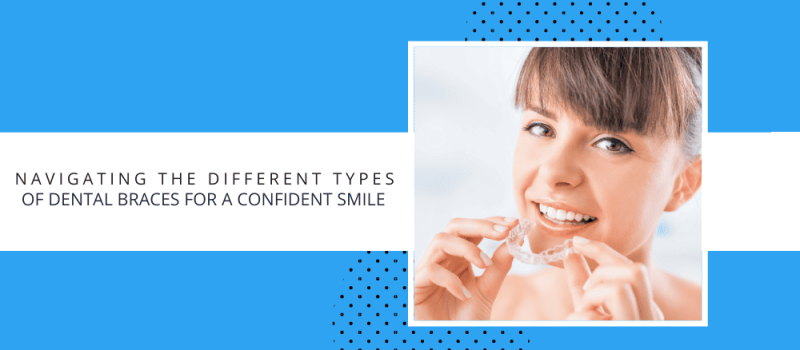
Orthodontics has evolved significantly, offering diverse options to correct misalignments and create beautifully aligned, healthier smiles. Join us, as we explore different types of braces – traditional, ceramic, lingual, and Invisalign clear aligners – providing insights into each option to help individuals make informed decisions on the journey to straighter teeth.
1. Traditional Braces:
The most recognizable type of braces are traditional braces. Traditional braces are comprised of metal brackets attached to each tooth and connected by metal wires. They work effectively by gradually shifting teeth into their desired positions. The modern version of traditional braces provides the wearer the option to customize their band colors and enjoy their colorful bright smile.
Pros:
- Effective for complex dental issues.
- Cost-effective compared to some alternatives.
- Suitable for all age groups.
Cons:
- Visible appearance.
- Maintenance requires adjustments and occasional tightening.
- Oral hygiene with braces can be a learning experience.
2. Ceramic Braces:
Ceramic braces share the same structure as traditional braces but use tooth-colored or clear brackets. These clear brackets blend more seamlessly with natural tooth color. This option appeals to individuals seeking a less noticeable orthodontic solution that is both aesthetically pleasing and effective.
Pros:
- Less visible than traditional braces.
- Effective for various misalignments.
- Suitable for both adults and teens.
Cons:
- More prone to staining than metal braces.
- Slightly more expensive than traditional braces.
- Oral hygiene with braces can be a learning experience.
3. Lingual Braces:
Lingual braces offer a discreet alternative as they are affixed to the backside (lingual side) of the teeth, rendering them virtually invisible. Lingual braces are customized to fit each patient’s teeth. Lingual braces are an appealing option for those desiring effective treatment without visible orthodontic appliances.
Pros:
- Hidden from view.
- Suitable for various misalignments.
- Customized for comfort.
Cons:
- Initial discomfort for tongue adjustment.
- Requires more maintenance and adjustment visits.
- Oral hygiene needs more upkeep.
4. Clear Aligners:
Clear aligners, such as Invisalign, represent a revolutionary approach to orthodontic treatment. These are custom-made, removable trays that gradually shift teeth into the desired position. Clear aligners are virtually invisible, providing a discreet option for those seeking a more flexible orthodontic solution.
Pros:
- Virtually invisible.
- Removable for eating and oral hygiene.
- Comfortable and less likely to cause irritation
- Easy oral hygiene access
Cons:
- Limited effectiveness for complex dental issues.
- Compliance is crucial for successful treatment.
- May not be suitable for all orthodontic cases.
Choosing the Right Option For You:
Severity of Misalignment:
- Traditional braces are effective for various misalignments, including complex cases.
- Clear aligners work well for mild to moderate misalignments.
- Lingual braces and ceramic braces are suitable for a range of misalignment issues.
Aesthetic Preferences:
- Individuals prioritizing aesthetics may opt for clear aligners, ceramic braces, or lingual braces.
- Traditional braces may be preferable for those focused on functionality and cost.
Lifestyle Considerations:
- Clear aligners offer flexibility with their removable design. Removable braces offer a versatile lifestyle.
- Traditional, ceramic, and lingual braces are fixed, requiring consistent wear. This means lifestyle modifications have to be made and certain foods need to be omitted.
Cost Considerations:
- Traditional braces are generally more cost-effective compared to other alternative braces.
- Ceramic and lingual braces may incur slightly higher costs.
- Clear aligners can be comparable or slightly more expensive, depending on the complexity of the case.
Orthodontic Goals:
- The complexity of the orthodontic issue influences the choice of braces.
- Clear aligners may be ideal for those with mild to moderate misalignments.
- Lingual and ceramic braces provide discreet options for more comprehensive orthodontic needs.
The world of orthodontics offers a variety of methods that cater to diverse preferences and orthodontic requirements. Consulting with an orthodontic professional in Redmond, Oregon is essential to determine the most suitable option for you based on individual needs and goals. Whether you opt for the tried-and-true traditional braces, lean towards the discreet ceramic or lingual braces, or decide upon flexible clear aligners, each orthodontic option paves the way to a confidently aligned smile. Schedule your free consultation with Sullivan Orthodontics and start your smile journey today!
